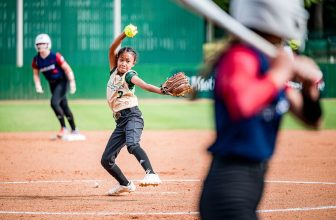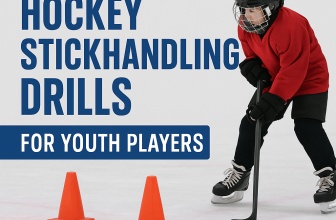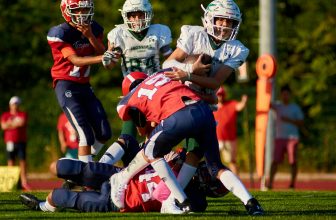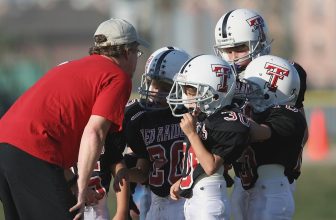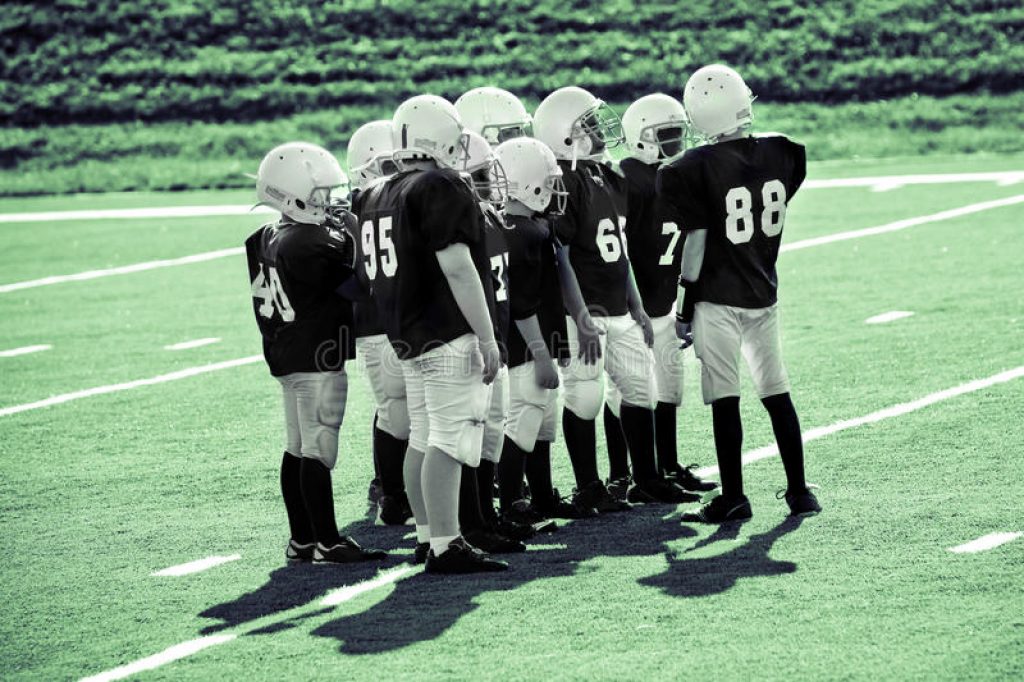
In football, the offensive side of the ball is easiest to control. You can build around the talent you have and even hide some weaknesses.
Good offenses are designed to do exactly that…build on your strengths and help you move the chains and put points on the board.
Of course understanding what each type of offense works best with is important. Here are the top 5 offenses for youth/middle school football and how they best align with the talent available.
#1) Double Wing
Double Wing provides a balanced formation meaning that there are an equal number of offensive players on either side of the formation. This means that the defense must balance their numbers to each side as well or risk being outnumbered which you can take advantage of as an offense.
In general, the Double Wing uses angle blocking which is easier on young offensive linemen. It also has a large dose of misdirrection in its playbook which becomes very difficult for young defensive players, especially the linebackers, to diagnose.
This means that you can create some big running lanes with ball handling and faking that is well executed.
The double wing allows for enough play action passing and because both flanks are tightened down, the passes are shorter but the run after catch opportunities give the receiver plenty of room to run with the ball.
In general, the idea is to spread the touches amongst all four backs including the QB.
Here’s a brief intro video to give you a better idea of the what the Double Wing can do for you:
Double Wing is best for:
- A team with plenty of running backs but maybe not that single “stud” runner.
- A team with average size to smaller linemen can benefit from DW
- A staff focused on teaching great ball handling and faking skills.
- A team not quite ready or able to develop an advanced passing attack
Here are some great Double Wing Resources:
Double Wing Multiple Formation
#2) Wing-T
The Wing-T is a close relative of the double wing. It also creates a balanced formation, but it is not a symmetrical formation like the Double Wing.
It usually includes one split end, although two tight ends can be implemented if needed.
Like the DW, it utilizes plenty of angle blocking and misdirection so that the smaller to average size line is utilized correctly. Also, the idea is to spread the ball amongst all four backs.
Because it usually includes a single split end, the team ready to implement more passing, especially three step dropback, is well suited to this offense. Even with one dominant receiver, the defense can be forced to put an extra defender out of the box which creates more advantages for the run game.
As players begin to grow and advance in their skills, a Wing-T team can transition to a shotgun version which starts to implement elements of the spread while maintaining the strong misdirection running game.
Wing-T is best for:
- A team with plenty of running backs but maybe not that single “stud” runner.
- A team with average size to smaller linemen can benefit from Wing-T
- A staff focused on teaching great ball handling and faking skills.
- At least one talented receiver
- A team ready and able to develop a more advanced passing attack with dropback
Here are some Wing-T Resources:
Wing-T Offense for Youth Football
#3) I and Power I Offenses
Power I provides some of the misdirection benefits of the DW/Wing-T because there are still four backs who can get the ball on any play. However, the offense does feature a tailback who is expected to be the best back of the group and therefore get the most touches.
The power I is best suited for teams not quite ready to develop a strong passing attack, though is can utilize a 3-step quick game if you have a single receiver who can split out.
From the I formation with only a fullback and tailback in the backfield, the offense can start to utilize a more advanced passing attack as two-receiver sides can be used to isolate certain defenders, and routes that flood one side of the field can be utilized as well to create stretches on the the secondary.
At the youth level, angles are still favored, but typically the fullback (plus the extra back in power I) are used to kick out or isolate defenders allowing you to create double teams on the line of scrimmage at the point of attack.
Power I/I Formation Offense fits best if:
- You have a stud running back who can handle the bulk of the touches
- You have an athletic fullback(s) to isolate and kick out
- You want angles and double teams for your offensive line
- You want to start building a more advanced passing game (two-back I)
- You want misdirection (Power I has more misdirection opportunities)
Here are some I/Power I Resources:
Power I Offense for Youth Football
#4) Air Raid
Year-in and year-out in college football, the Air Raid teams lead in several statistical categories. That doesn’t mean you should plunge your youth or middle school team into the deep end of the pool when it comes to offense, because the Air Raid does require some more advanced skill and line play.
However, if you have some bigger, more talented linemen who can move their feet to protect, and you have a group of youngsters who have the ability to throw and catch, the Air Raid is worth exploring. If the players are able to run this, it can be a very fun offense to play and coach in.
While the DW/Wing-T require four skill players, the Air Raid requires six, and all should be able to catch the ball proficiently.
The Air Raid offense is simple enough for young players to master. Air Raid guru Mike Leach (Mississippi State) keeps his play calls on a small sheet of paper about the size of an index card. A few simple concepts which teach all the pre snap and post snap keys allow all six eligible players a chance to get the ball on any single play.
Of course the kids love it because it looks a lot more like the game they see on Friday nights and Saturday and Sunday afternoons.
Air Raid is for you if:
- Your program has already developed the passing and catching skills necessary for the Air Raid, like a strong flag football program
- You have at least six skilled players who can catch
- You have a strong armed quarterback who can make good decisions and distribute the ball
- You have linemen who are athletic enough to pass protect and strong enough to drive block one on one
- You play in relatively favorable conditions – mud, wind, and rain can hurt this offense at the lower levels
Here is a FREE Air Raid Resource:
Complete Middle School Air Raid Webinar Series
#5) Spread Offense Variations
Spread offense is not as descriptive as a term as you would think. There are run heavy spread offenses that utilize plenty of misdirection like the DW/Wing-T and there pass heavy spread teams that are more like the Air Raid.
In general, these offenses become more suitable to players as they get into middle school. These type of offenses are predominant at the high school level and beyond.
They allow for a coaching staff to tailor an attack to what they have, but without organization and discipline by the coaches in putting together a cohesive attack, they can become a jumble of plays that get bogged down because of a lack of a progression.
These type of offenses are more suited to experienced coaches with a strong understanding of offensive football. While the previous offenses described are more suited to a staff who is looking for an “off the shelf” solution.
Many elements of the other offenses described can be included and usually are. The main thing is that the staff understands what their starting point and base is because creativity can actually get in the way of execution.
Players execute best the things that they are able to repeat over and over, so at the heart of any youth offense needs to be a disciplined approach to coaching the fundamentals in detail.
In general, versions of spread fit best when:
- The coaching staff is more experienced
- You have enough coaches to coach the various skill sets needed
- You have a talented group of offensive linemen
- You have a center who consistently make the snap (95% plus or you are wasting too many plays recovering bad snaps and putting the offense behind the chains)
- You have a talented QB – run or pass emphasis still requires decision making so that the defense can not overload any part of the attack
- You have talented receivers who can catch and block on the perimeter
Here are some Spread Offense Variations:
Bonus: The RPO (Run-Pass-Option)
The RPO can and is utilized in almost every type of offense which starts with a shotgun snap. It is an advanced concept for youth and probably better suited for middle school and beyond. However, some simple RPO can be utilized and will create some big plays because youth football defenses just are not ready to defend them.
The sound advice we can offer is to keep them simple and limit yourself to one or two max.
Because the passes are short, from a throwing ability perspective, they are viable. Remember that these require the QB to react and make a decision, and that does take time to develop.
Here are some youth RPO resources:
10 Personnel RPOs for Middle School
Remember that good coaching is based on knowing what your players do well and then teaching them to execute to the best of their ability. More plays do not mean more success. Successful execution comes from repetition.
Good luck as you prepare for the 2025 season!
- Youth Football Coaching



